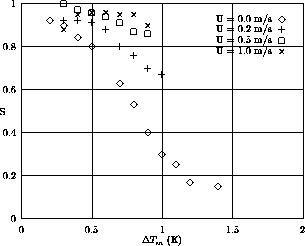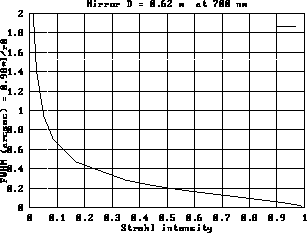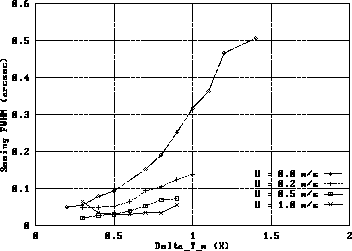



Next: Seeing tests on
Up: Experimental studies
Previous: A mirror seeing
A Japanese team from the National Astronomical Observatory, Tokio,
performed a mirror seeing experiment ([Iye]) with a 62-cm mirror
setup which had been originally conceived to verify the feasibility of
a new active optics system.
The test setup is shown in fig.  : the wavefront from a
65-cm horizontal mirror was measured by means of a Shack-Hartmann
analyzer and expanded by Zernike polynomials. The image quality under
the presence of seeing degradation was expressed by evaluating the
Strehl ratio by the expression
: the wavefront from a
65-cm horizontal mirror was measured by means of a Shack-Hartmann
analyzer and expanded by Zernike polynomials. The image quality under
the presence of seeing degradation was expressed by evaluating the
Strehl ratio by the expression

where  is the measured wavefront rms error.
is the measured wavefront rms error.
The mirror was not actively heated or cooled but its temperature as
well as that of ambient air followed slightly different
diurnal variation cycles so that most of the time there was a
mirror-air temperature difference.
In order to measure the effect of forced ventilation, the upper surface
of the mirror was flushed by the air flow created by an electric fan
with a flow-guide nozzle as illustrated in fig.  .
Unfortunately
the experimenters did not measure the value of turbulence intensity
of the air flow from the fans. An estimate may be obtained from
the measured velocity profile.
The measurements were carried automatically over 90 full days.
.
Unfortunately
the experimenters did not measure the value of turbulence intensity
of the air flow from the fans. An estimate may be obtained from
the measured velocity profile.
The measurements were carried automatically over 90 full days.
Fig.  shows the average Strehl ratio measurements
reported by [Iye]
as a function of the mirror-air
shows the average Strehl ratio measurements
reported by [Iye]
as a function of the mirror-air  for different flushing
speeds. We note that the method used to derive the Strehl ratio
from the wavefront
aberrations through equation (
for different flushing
speeds. We note that the method used to derive the Strehl ratio
from the wavefront
aberrations through equation ( ) becomes more
and more inaccurate for
) becomes more
and more inaccurate for
 or
or  .
.
When the mirror was colder than ambient air the image quality remained
perfect and no seeing was found for the range of mirror-air
 s up to -3K covered by the experiment.
s up to -3K covered by the experiment.

Figure: Layout of
the mirror seeing experiment by Iye et al.

Figure: Measured Strehl ratios versus mirror-air temperature difference for
the 62-cm mirror (as reported by [Iye]).
For the purpose of comparison we have converted the Strehl ratio
values to FWHM seeing values by means of the SuperIMAQ computer
program for the analysis of mirror image quality [ESO].
The seeing values in term of seeing FWHM are then plotted in
fig.  .
.

Figure: Relationship between seeing FWHM and Strehl ratio for a 62-cm
mirror (computed with the SuperIMAQ program).

Figure: Seeing FWHM versus mirror-air temperature difference for
the 62-cm mirror.




Next: Seeing tests on
Up: Experimental studies
Previous: A mirror seeing
Lorenzo Zago, lorenzo.zago@heig-vd.ch,
Mon Nov 6 23:33:14 GMT+0100 1995
 : the wavefront from a
65-cm horizontal mirror was measured by means of a Shack-Hartmann
analyzer and expanded by Zernike polynomials. The image quality under
the presence of seeing degradation was expressed by evaluating the
Strehl ratio by the expression
: the wavefront from a
65-cm horizontal mirror was measured by means of a Shack-Hartmann
analyzer and expanded by Zernike polynomials. The image quality under
the presence of seeing degradation was expressed by evaluating the
Strehl ratio by the expression





 is the measured wavefront rms error.
is the measured wavefront rms error.
 for different flushing
speeds. We note that the method used to derive the Strehl ratio
from the wavefront
aberrations through equation (
for different flushing
speeds. We note that the method used to derive the Strehl ratio
from the wavefront
aberrations through equation ( or
or  .
.
 s up to -3K covered by the experiment.
s up to -3K covered by the experiment.



